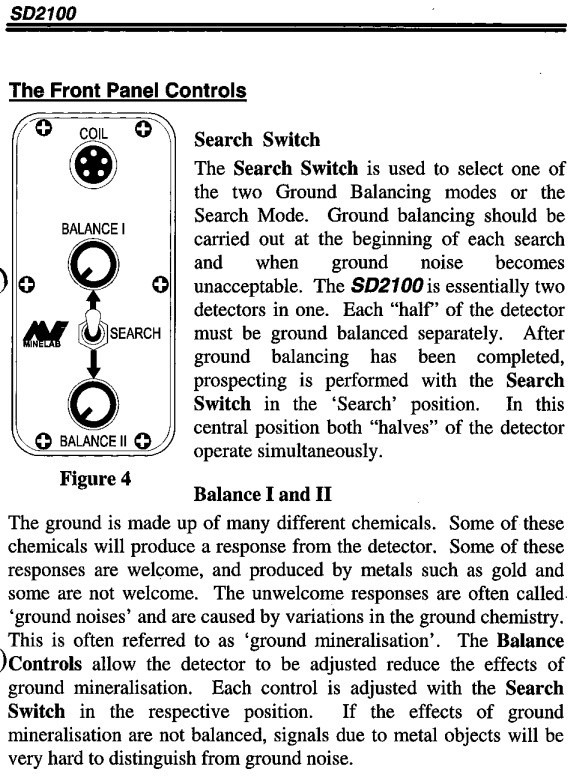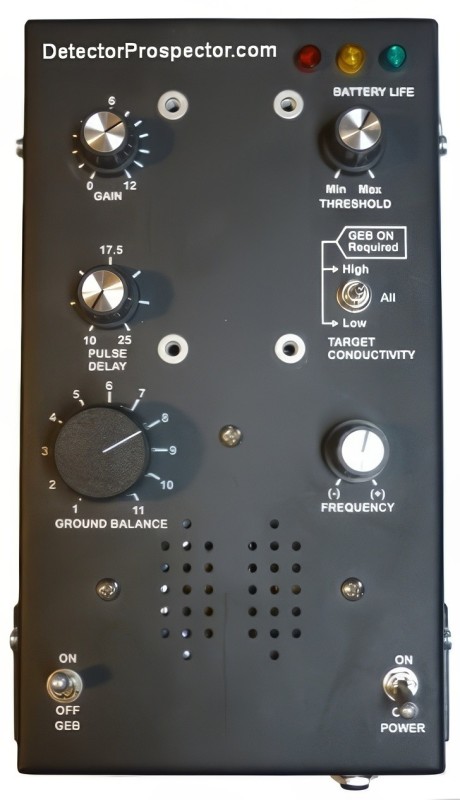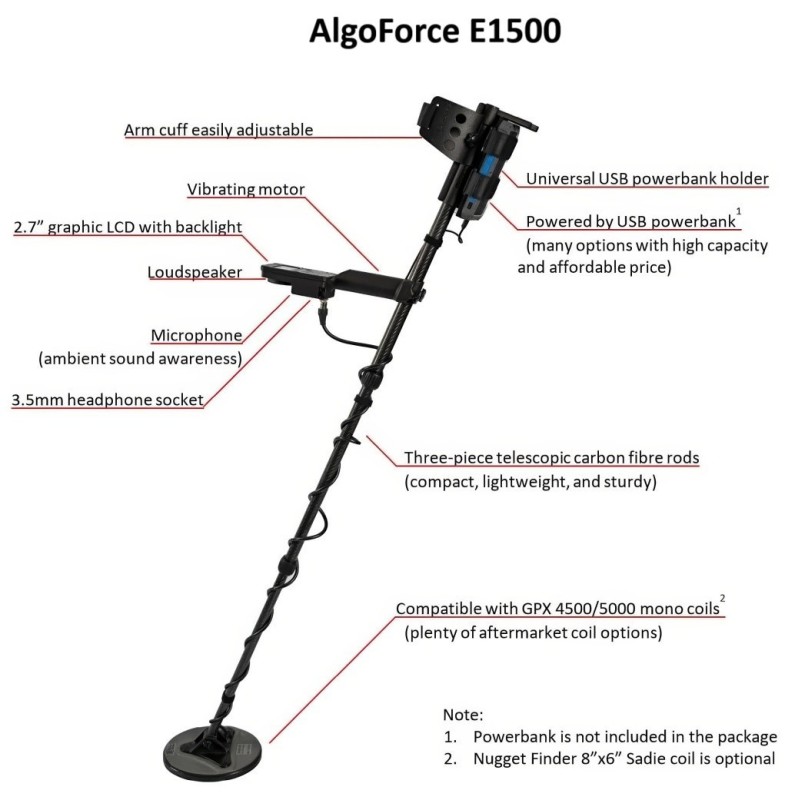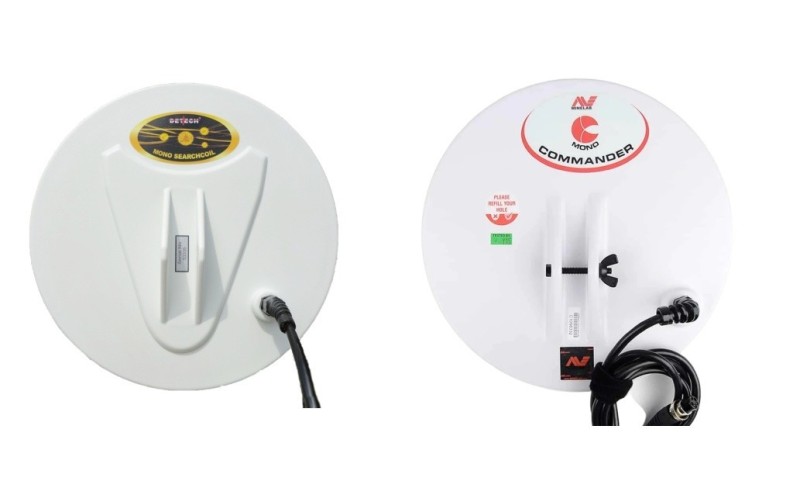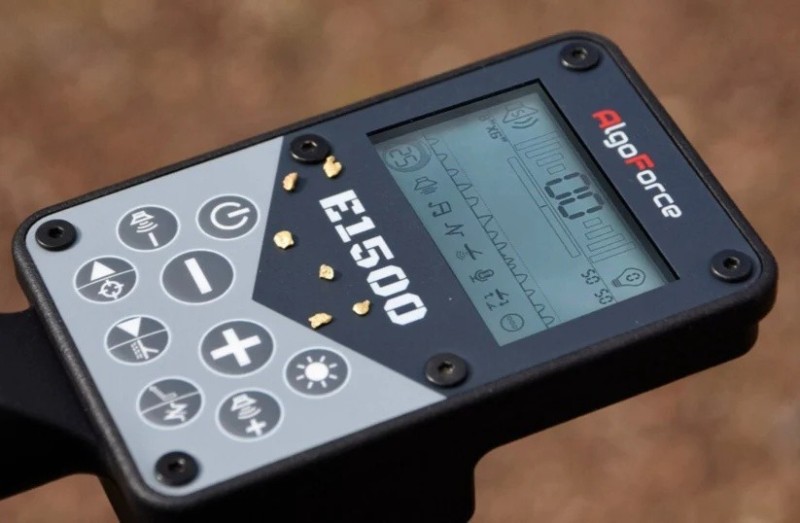-
Posts
19,665 -
Joined
-
Days Won
1,560
Content Type
Forums
Detector Prospector Home
Detector Database
Downloads
Everything posted by Steve Herschbach
-
Just to clarify for people who don't know what dual channel and single channel PI is all about. Early PI did not ground balance per se, they relied on the pulse delay to take out the ground and saltwater. This was insufficient however for real bad ground commonly encountered by gold prospectors. I think it was Eric Foster who came up with the first widely sold PI with an actual ground balance. A simple knob as seen on the TDI which was originated in Erics Goldscan models. Unfortunately a PI ground balance setting creates a huge "hole" where certain targets get eliminated at common ground balance settings. Like 1/4 oz nuggets and certain gold rings for example. Bruce Candy came up with the idea of having two ground balances, each one creating a "hole" at different locations on the scale. The two "channels" as he called them were compared, and if one channel lost an item in the hole the other found it, and by comparing the two channels properly targets missed by single channel systems were revealed. This is all explained by Brent Weaver in the first link I gave in the last post. Single channel single ground balance PI creates two classes of targets based on the ground balance setting. Dual channel can create three classes. The early Minelabs actually has two separate ground balance controls that separates them from machines like the TDI. Then Minelab and Garrett learned to manipulate both channels simultaneously for better results. Yet the ability to manipulate the dual channels separately was lost, and I may have to pick up an old SD2100 to be able to play more directly with this stuff. Again, this is all explained in much greater detail at the second link I provided above. From the SD2100 manual:
-
No, White's never had a dual channel (two ground balance points) PI. Bruce Candy invented it and it became the basis for Minelab's SD2000 when White's passed on a chance to buy the tech from Bruce. One of the worst decisions in detector history. The TDI was licensed from Eric Foster much later in a bid to catch up, old school single channel. Garrett was actually second with dual ground balance channel PI with the Infinium, then ATX and now Axiom. A really great explanation from an actual engineer instead of me.... https://www.detectorprospector.com/topic/559-interview-with-brent-weaver-senior-design-engineer-garrett-metal-detectors/ PI discrimination based on eddy current decay is as old as PI and inherent in the tech. Every model with a pulse delay control is a "discriminating PI" and some companies like Garrett have marked and sold the control as a disc control for a long time. This is old stuff and if it were so simple as programming a few things it would have been done ages ago. Normal PI disc as employed with eddy current delay is based on both size and conductivity and even shape. You can only speak in generalities. There are huge amounts of overlap on target types and only useful in site specific situations with a knowledgeable operator. Ground balancing PI has a secondary form of discrimination based of the ground balance setting. The conductivity id is depth limited but the tones based GB disc goes to full depth. Fisher gave this a go with the Fisher Impulse AQ using the ground balance as a disc control instead of ground balance. Still you are basically correct that with high speed signal processing and comparison of the results of the two different id information streams available (Conductivity and GB Comparative) there is a lot more than can be done with PI disc in electronics. Right now it can be done by people who understand all this stuff by using audio and control manipulation, but 90% of the time VLF users are upside down and backwards in their thinking as regards PI disc. I don't know how many times I have heard people who don't know say the systems are depth limited and set up various straw man arguments about why PI disc is useless, when in fact it is being used all the time. Just ask anyone detecting for relics at Culpepper about PI vs VLF and how good a person can get at cherry picking targets at depth. Let alone guys like me that can cherry pick the vast majority of gold nuggets out of trashy old mining locations. I almost give up explaining it anymore but did make one last attempt at bringing all my posts over the years together into one linked set. It actually requires study and thought to understand as well as tossing all VLF preconceptions. For anyone who wants to give it a go, here it is. You have to read the entire thread plus the links I provided to get the whole picture. Now what AlgoForce brings to the table with the E1500 is advancing the Conductivity ID into giving us a 0-99 numeric reading, vastly improving on the Minelab blanking system and Garrett grunt system. This will probably be depth limited but will give a much finer degree of information one can use to make decisions. Coins in particular should give steady consistent readings. However, it may not be any better than a good multifrequency as far as depth. The dual tones the E1500 produces on the other hand will give two classes of targets to full depth very similar to the Minelabs, Garretts, and TDI. By using both in conjunction I anticipate a step forward in melding both deep target and shallow target id capability in a PI, but again the VLF naysayers should just ignore and be happy. I'm fed up with that lot. I will not debate with anyone how useful any of this is or not. I simply want to use my tools to full capability, not convince others they need to use them.
-
The bare basics of PI is the pulse delay. VLF is called Frequency Domain because it is frequency based. Pulse Induction is called Time Domain because it is time based. VLF continuously transmits and receives at a given frequency or frequencies. PI transmits, pauses, then receives. The pause is the Pulse Delay and varies in length - time. A current is induced in targets during the transmit phase, and the induced eddy current is what is picked up in the receive phase. This induced current rapidly decays - weakens - until it is gone. Different targets decay at different rates. Most ground and hot rocks decay faster than metal items. By setting the pulse delay long enough, you can ignore ground while still detecting those metal targets in the receive phase. Many PI detectors have a simple knob variable control that allows you to vary the pulse delay, and therefore what the machine picks up and ignores. Small targets and low conductive targets decay the fastest and so get eliminated first. The more conductive and larger the target, the longer it retains the eddy currents. There is no ferrous vs non-ferrous and ferrous is treated mainly based on size which in turn governs how long it retains eddy currents. It all revolves around time - how long is the pulse delay? Then Minelab came up with dual channel PI where you have two channels each running different delays at different times. It was not much of a leap for them to start calling these different mixes of channels and pulse delays "timings." This is a picture of the White's TDI Pro control set, pulse delay in middle left, range from 10uS to 25uS (microseconds)
-

Early Field Review Of AlgoForce E1500
Steve Herschbach replied to PhaseTech's topic in AlgoForce Metal Detectors
A reality check. The GPX 5000 has been discontinued. These are the near future options under $4000 new with warranty in the U.S. : $3995 Garrett Axiom (with two coils), 4.2 lbs, 6 coils, not submerisble $3599 Minelab SDC 2300, 5.7 lbs, 4 coils, waterproof but not really submersible $2120 Garrett ATX, 6.9 lbs, 5 coils, fully submersible $1800 AlgoForce E1500 ($1530 + $240 6x8 mono + $30 Power Bank), 4 lbs, dozens of coil options, not submersible The ATX seems totally forgotten now as a nugget detecting option, never getting mentioned by anyone anymore. That leaves the SDC 2300 as the next closest option to the Algoforce that really being considered by people. The Algoforce is exactly 1/2 the price of that nearest other option. Now maybe that does not matter to you guys, but I’ll bet Doc and Gerry can both confirm it matters to a lot of other people they deal with. -

Early Field Review Of AlgoForce E1500
Steve Herschbach replied to PhaseTech's topic in AlgoForce Metal Detectors
Setting this up as the E1500 must beat a detector that sells for three times as much is pie in the sky dreaming. "Make old patches come alive." Yeah, right. Just go use the 6000 and be happy. -

Minelab GPX 5000 Discontinued In U.S. ?
Steve Herschbach replied to Steve Herschbach's topic in Detector Prospector Forum
They still make the Gold Bug 2 after 40 years and many component substitutions. I'm sure they could keep the 5000 going if they wanted to. But by todays standards it is an expensive machine to manufacture and separate batteries are getting to be a shipping issue. The real hope for us all is they simply have something better waiting in the wings. A GPX 5000 in a CTX 3030 housing waterproof to ten feet - sign me up!! https://forums.robsdetectors.com/topic/9655-minelab-ctx-5000/ -
An interesting problem develops that as PI gets close to VLF sensitivity to small targets, it also lights up hot rocks a PI user never knew existed before. There is a balance there and it is extremely site dependent, not a this or that thing. I almost feel like getting the Sadie was a mistake but then again I won't know until I use it. My gut feeling is I will be using it in my worst or the worst areas, where the spiral wound advantage may actually be a disadvantage. Probably have to get both eventually but that can wait until I have an E1500 and actually use it enough with the Sadie to get a feel for it. I'll know pretty quick if the ground is challenging the Sadie that going to a spiral would not help... but then I wonder if how a spiral in Fine does versus the Sadie in Ultra Fine? Good news about a 6x10 as that gives me reason to wait anyway.
-
Actually it just has to be good at a decent price. Word of mouth is the strongest force in the metal detecting community, especially in the largest markets. You are assuming they are a mom and pop outfit with shallow pockets. Well, they had enough to make 100 up front and sold them in two days so the pockets just got deeper fast. The reason I have hammered on somebody making a machine like this for years is because in my estimation it would not have to be "sold" but would sell by filling a gaping hole in the market. Give people what they want and reap the rewards. A well made good performing under 4 lb under $2K PI detector was the biggest most obvious apple left to pick in this market. No, they need not hire some big marketing gun nor give away the company. Though people with money to spend would love to get a piece of this action. I would have already tried to corral exclusive U.S. distribution rights were I still in the mood to work at all.
-
Had a dealer friend make an inquiry and sounds like they are nowhere near ready to sell in the U.S. A prime problem right now might come from being able to fill the demand they already have. If they get ahead of themselves and can't fill demand where they are and exacerbate that by chasing new markets too soon it does not help them really. More like robbing Peter to pay Paul, so I expect responding to what might be a surprising amount of demand is the focus of the moment. If there is any good news I guess it is that any issues will get sorted out in Oz first before it gets here. It will also provide a waiting period for people who might have jumped the gun and bought one, who can now let that fire cool before making a decision, one based on user accounts from others.
-

AlgoForce E1500 And Pi Discrimination
Steve Herschbach replied to Steve Herschbach's topic in AlgoForce Metal Detectors
Target id for some nuggets and Aussie coins here.... https://www.prospectingaustralia.com/threads/algoforce-e1500-new-pi-detector-from-ex-minelab-engineer.42049/post-676638 -

Early Field Review Of AlgoForce E1500
Steve Herschbach replied to PhaseTech's topic in AlgoForce Metal Detectors
Target id for some nuggets and Aussie coins here.... https://www.prospectingaustralia.com/threads/algoforce-e1500-new-pi-detector-from-ex-minelab-engineer.42049/post-676638 -

Early Field Review Of AlgoForce E1500
Steve Herschbach replied to PhaseTech's topic in AlgoForce Metal Detectors
Is it really necessary Reg to take a dump on what other people consider fun? To each their own. I was out this week and would have been happier with a speck than the skunk that came home with me. -
Target id for some nuggets and Aussie coins here.... https://www.prospectingaustralia.com/threads/algoforce-e1500-new-pi-detector-from-ex-minelab-engineer.42049/post-676638
-
Be silly to sell it when I have not even taken delivery of it yet.
-
It won’t. Expecting miracles is just a setup for failure. If discrimination is the most important factor stick with VLF.
-

Detech Vs Commander 11 Mono?
Steve Herschbach replied to Steve Herschbach's topic in Detector Prospector Forum
I’m looking at the Sadie as my small coil so this would be the “big coil.” I have had a few Detech coils and I have to say the 13” Ultimate was one of the best coils I ever owned, period. Looks like Detech it is. Thanks everyone. -
Sounds like most of the detectors and coils announced in the last ten years! My crystal ball says GPZ 8000 for $12,000 announced by end of the year, available in 2025. Detects a 36 ounce nugget deeper than a GPZ 7000. Just that one nugget will easily pay for it! The E1500 will be available for purchase in states within 90 days. If I am wrong on any of that I will fully refund every dime you have paid for my prediction.
-
Has anyone ever used both or at least the Detech and have any comments at all? I'm confident enough in the Commander but wonder if the Detech might be a better option. Basically going to use for looking for coins and better yet rings at the beach so don't care about hitting tiny bits, in fact prefer not doing that. Detech has the spec edge at 780 grams versus Commander at 820 grams. Detech is rated waterproof whereas Commander is only rainproof. Commander coils I am pretty sure are Litz wire. Not sure about the Detech.
-

Axiom, Outrageous Settings That Work In Black Sand
Steve Herschbach replied to Knomad's topic in Garrett Metal Detectors
I do understand what you are saying and a lot of my comments are just for the general audience reading this thread. I know you are not picking the 00 00 setting per se but you are in a way, by trying to balance on ground that is overloading it, forcing it to go to 00 00. Do a reset and just don't ground balance at all. Or do a partial ground balance higher above the ground, or on milder soil nearby. Just don’t let it get to 00 00. The guy shows what I am talking about in this video. I would test both without any ground balance at all, and at the 00 00 setting. Set your other controls like you have been doing, and see what gives the best result. Since you are not ground balancing there is ground response normally, but a PI is forgiving and coil control can compensate. Your settings should suppress that in any case. Just making some suggestions and I appreciate what you are saying and passing along, more information is always good, and I’ll give it a go myself and report back, thanks! -

Axiom, Outrageous Settings That Work In Black Sand
Steve Herschbach replied to Knomad's topic in Garrett Metal Detectors
In proper tuning technique we are not supposed to tune detectors to targets in the air. The main goal should be to tune the detector for stable operation against the ground. Only by getting properly tuned to the ground can you get the best performance. That may mean it does not detect as deep or as small of objects in the air - but we are not detecting in the air. Detectors can only do what they do and so you tune up for the ground, and then you get what you can get. If your detector is not up to the task, then get a different detector, but no tuning magic will give you air depth in the ground. In some places you will get half the depth or less of what air tests show, and in the rarest location, detectors will not work at all. -

Early Field Review Of AlgoForce E1500
Steve Herschbach replied to PhaseTech's topic in AlgoForce Metal Detectors
Added the E1500 to the Detector Database and noticed that due to the company name starting with an A they will be first in alphabetical lists. Smart move that even if it was not planned. It is why you see so many triple A company names. -

Axiom, Outrageous Settings That Work In Black Sand
Steve Herschbach replied to Knomad's topic in Garrett Metal Detectors
Me for one. I was running a similar ultralow sensitivity while coin detecting in a park with the Axiom. I would expect it would work better if you did not ground balance it into the 00 00 set point but would use the default GB setting instead, or do as I described in an earlier response to you and get it close without going over the edge. I honestly have not tried 00 00 however as I made an incorrect assumption the machine was crapped out with that indication, so worth a go both ways. But yeah, people for some reason think setting like 1 are put on detectors as placeholders that serve no purpose. If it was never supposed to be run on 1 it would not have that setting. A majority of detectorists (not saying you, just in general) do not seem to understand that the ground determines the gain settings. If you go too high in bad ground the blowback from the ground actually means LESS DEPTH. Reducing the sensitivity and other related settings to appropriate amounts gives BETTER DEPTH. It does not matter what the settings are per se, just that they are just below the tipping point into the blowback situation. Good to hear it sounds like you are having fun! -
I will just say that I know of detector testing by all companies including U.S. companies prior to FCC certification because you can’t certify unrealized product and can’t make product without tests. But where the lines and limitations are to that I don’t know. You know darn well people order detectors from overseas all the time and use them here even though they are not FCC certified. It’s not like the FCC has spies behind every tree and the detectors probably comply anyway. They just did not pay to be tested.

